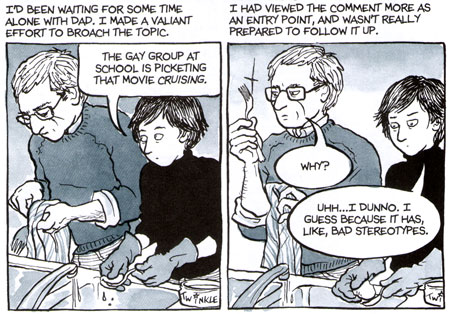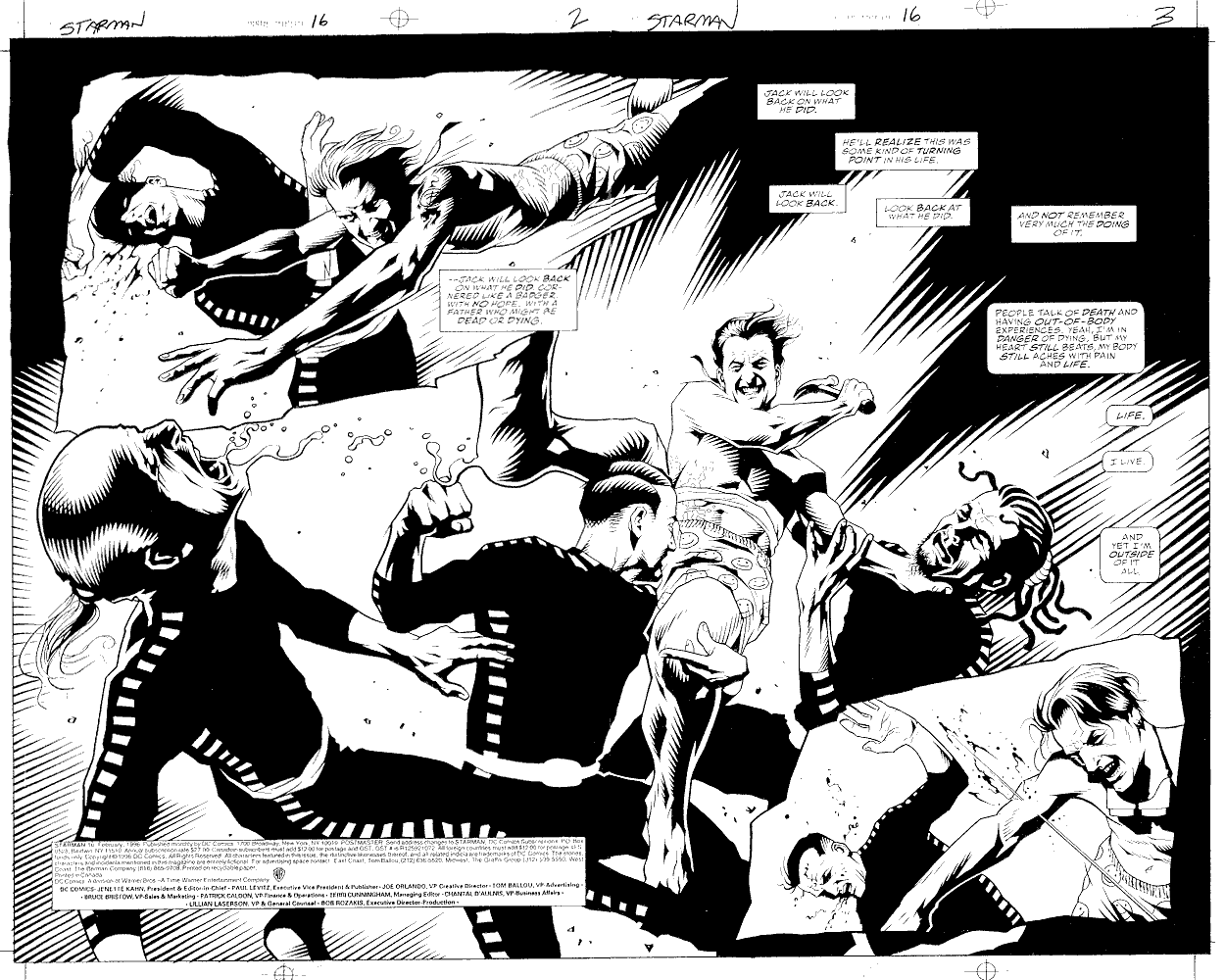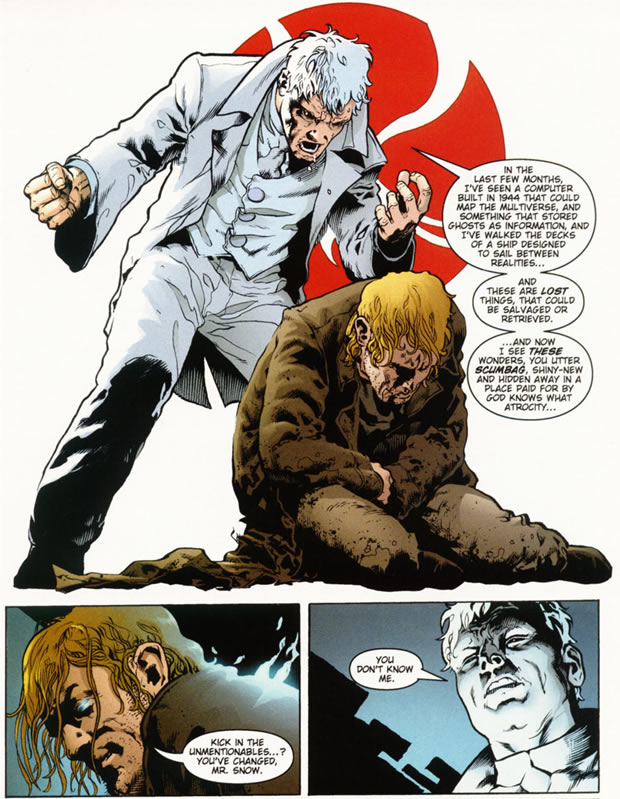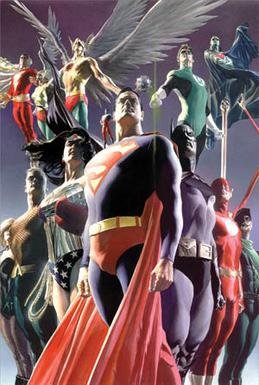This is basically a rant I posted on the Comic Book Resources message board, in the You'll All Be Sorry section. The discussion was Wizard Entertainment's
How To Draw Comics books. Go
here for the full context. I've added many links and clarified a few ideas.
Before I begin the lecture, let me tell you my credentials. I graduated from the
School of Visual Arts in 2000 with a BFA in Cartooning. Among my teachers were Carmine Infantino, Sal Amendola, Jack C. Harris, Tom Palmer, and Klaus Janson. Will Eisner, Harvey Kurtzman, art spiegelman, and Walt Simonson used to teach there. Joe Quesada (EIC at some company called Marvel) graduated from there, as did Patrick McDonnell (Mutts comic strip). Becky Cloonan (indie artist extraordinaire) was a year behind me. Khary Randolph (TMNT & Boondocks style guides, Spiderman & Teen Titans Go!) was in my classes. I'd estimate 1/5 of the people working in the comics industry (artists, editors, production artists, colorists, letterers) had some education at SVA.
Q: But Jeff, if you're so damned self-righteously qualified, how come you're not drawing comics?
A: Because right after graduation, I had to deal with a Fuckton™ of personal issues and pretty much forgot everything I learned, then lost the will to draw, fell into a deep depression, etc, etc.
(Fuckton™ 2006
Kevin Church.)
Q: Geez, you artist types are a temperamental bunch.
A: Tell me about it.
Lately, I've been feeling the itch to draw again. Although I was creatively dormant, I did not stop searching for information. I'm going to share a few ideas, and list many books for you to look up. Ready?
ABOUT ART:Pay attention in art class, and ask your teacher for help.
In order to learn how to draw, you must learn how to see. Therefore, draw from life. If you can't draw from life, draw from photos.
If you're going to draw,
draw every day.Ask a friend to sit still for a while and draw him. Don't get discouraged, don't worry about mistakes, don't worry if your model moves. Use your whole arm, not just your wrist and fingers. Use as much time as you can.
Pick up Dr. Betty Edwards book
Drawing on the Right Side of the Brain. I read this book a few months ago. Great googley moogley, it sure did make a few synapses fire. Dr. Edwards covers the physical and mental processes of drawing (how the brain works when drawing), as well as a bit of art history. She also covers proportions, perspective, texture, light & shading, color, space, and composition. You don't need a PhD to understand the book. Take it slowly if you need to.
Now that you're pretty good at Seeing, it's time to get a bit more technical. You have to start Knowing. Specifically, human anatomy. As hinted at, there are Fucktons™ of anatomy books.
Alex Dragon made a few great recommendations, and anti-recommendations. Artists
Walter Foster,
George Bridgman,
Jack Hamm or
Andrew Loomis are masters. Avoid
Christopher Hart and
Burne Hogarth. They both have warped senses of reality and proportion.
Quote:
| Originally Posted by Alex Dragon Basically you don't want to learn to draw from comics. |
There's a few Fucktons™ of Truthiness in that.
Q: You like saying "Fucktons™" a lot, don't you?
A: You bet I do. I try using it everyday, in normal conversation. Moving along...
There's a good book called
An Atlas of Anatomy for Artists by Fritz Schider. It combines photo reference, sequential frames from film of moving figures, studies from Michelangelo (and other Turtles/Artists). It uses male and female models, ranging from ages 4 to 19, so you get a good range of anatomical development.
Alex also mentions that you avoid "the big thick expensive anatomy books. Most of them have way too much info that you'll most likely will never need or use." He's right, for the most part. I have two, and I got them for free. There's another that I bought, that's loaded with photo reference with transparent overlays. It's called
Anatomy for the Artist by Sarah Simblet. It's a really beautiful book, full of very healthy & athletic models. I really recommend it.
The other two I have are
Anatomy for the Artist by Jeno Barcsay, and
Cyclopedia Anatomicae by Gyorgy Feher and Andras Szunyoghy. The latter features indepth studies of many animals, like horses, dogs, cats, and others. This book is HUGE. I love it.
Q: You forgot the accent marks on those authors names.
A: Please. You're lucky I
tried to spell them right. I'm not opening up Windows Character Map for this.
Q: All this talk about anatomy is killing my need to draw titties.
A: 90% of the books I'm telling you about has many pictures of naked women.
Q: Only 90%?
A: Actually, it's probably less than that. More like 60%.
Q: Dang.
A: Trust me, there are LOTS of naked women in these books. It makes up for the other 40%.
Q: It better!
A: Dude, the next three books are 90% naked women. I'm not lying this time.
Q: What's the other 10%?
A: Naked guys.
Q: AWWWW, you mean I can see their wang flopping around?
A: Eh, you'll get used to it. After four years of life drawing classes, simple nudity will stop affecting you. Now be quiet.
The Nude Figure by Mark Edward Smith,
The Figure in Motion by Thomas Easley & Mark Edward Smith, and the
Atlas of Foreshortening by John Cody with Ron Tribell.
Q: I'll bite. What makes these books so great?
A: For starters, it's all photo reference, full of healthy, athletic models. They are all in great poses at different angles. You know all that anatomy you just learned? These books show you more about how they interact with each other, with the skin over the muscles. You get to see all the "landmarks."
Q: BORING.
A: Turn to pages 79-81 of The Nude Figure.
Q: *drools*
A: Are you done questioning me?
Q: Yes, sir. Sorry, sir.
Since we're now looking at more surface detail as opposed to the underlying structure, I'll bring up Alex's other good point:
Quote:
| Originally Posted by Alex Dragon Buy a couple of Muscle mags to get a understanding of what exaggerated muscles look like on a figure. |
This is good because it's still actual human anatomy, and not some freak experiment from Rob Liefeld's laboratory. You can learn how to apply the steroid-fueled anatomy to the poses from the other books.
Q: Yeah, but those muscle mags...the women scare me.
A: It's okay, just think happy thoughts.
Q: Pages 79-81...
A: That's the Spirit.
Q: I've heard of him.
A: I'll get to that soon.
There are three other books that are just about drawing I think you should consider. The first is
The Artist's Complete Guide to Facial Expression by Gary Faigin. If you're really into drawing in the anime style, this will help you immensely. You know how lots of artists use emotional shorthand, like the throbbing X veins on the forehead, or the giant teardrop? Those people are lazy. It saddens me that we have to resort to using multiple symbols to convey emotion instead of just drawing it right in the first place.
But if that's your bag, then fine. I won't bitch about it any more.
The next two books deal with the same concept, energy in drawing. One is called
High Focus Drawing (which seems to be out of print) by James McMullan, an instructor at SVA, who came up with the department within the department.
The other is called
Force by Mike Mattesi. I took the HFD class, and had a bit of trouble getting it at the time. Towards the end of the year, I made some breakthroughs. If you want your characters to breathe, to jump off the page, you may want to give it a look.
Now, let's talk about comics specifically.
ABOUT COMICS ART:Q: FINALLY! You're a wordy bastard, aren't you?
A: It depends on the subject. I'm usually the quiet type.
The rest of the books I'm going to cover overlap in subject matter, because they are specifically about the Art of Comics. I'll try to make this as easy as possible.
How to Draw Comics the Marvel Way by Stan Lee and John Buscema is a GREAT overview of the creative process, even if it is outdated in parts and very basic in terms of the different aspects of cartooning.
Understanding Comics by Scott McCloud gives you the history of Comics, by way of an art history lesson. Comics have been around since at least 1300 BC, in the form of Egyptian hieroglyphics. As Will Eisner said, "UC is a landmark dissection and intellectual consideration of comics as a valid medium. Everyone...anyone interested in this literary form must read it."
McCloud's follow up book,
Reinventing Comics isn't really necessary, but it's still a very interesting discussion. His most recent book,
Making Comics, is extremely helpful regarding storytelling techniques (specifically from "indie" comics and manga) and other aspects of comic creation.
Q: Will Eisner...I've heard of him. He did that Spirit guy, right?
A: Oooh, lordy, that ain't all he did. Will was the first guy to really examine what can be done with comics. He practically invented the graphic novel. He wrote the first textbooks on how to properly tell stories through comics. The first is
Comics & Sequential Art, the second is called
Graphic Storytelling. Another book he wrote was a collection of discussions with many artists about the medium called
Shop Talk. I also recommend reading his biography
A Spirited Life. You get a good idea as to how influential he was on the industry during the Golden Age. I'd also suggest reading
Eisner/Miller, where the two artists talk about the medium. It's not nearly as vital, but hearing two legends talk about the craft is pretty damn cool.
Q: I take it Will is an important guy.
A: You don't know the half of it.
Klaus Janson used to hammer into our heads every week in class, that storytelling hinges on two elements:
Clarity, and Entertainment. This is Eisner's lessons distilled into a sound bite. It's something to keep in mind while you're at the drawing board. In order for other people to understand the story, things must be done clearly and effectively. If something doesn't make sense, there's risk of losing the reader. Once you've got clarity, then work on making it look interesting, make it look entertaining. The story can be as clear as day, but if it's boring, the reader is already mashing buttons on his Xbox controller.
Now, for something more technical, I offer
Perspective for Comic Book Artists by David Chelsea.
Q: Oh, my head.
A: It's cool, trust me. Like Scott McCloud in Understanding Comics, he teaches you about perspective by telling you about it in the form of a comic story. Will Eisner was the first person to use comics as a teaching tool, while he was in the Army during WWII.
Q: Okay, I get it, Eisner is very important.
A: They didn't name an award after him for nothing, you know.
Let me get back to some good points from another poster:
Quote:
| Originally Posted by Samurai |
I don't actually own those books. Yet. I've looked them up, and they seem pretty good, especially Jeff Johnson's.
Also worth a look at is
Muscles in Motion: Figure Drawing for the Comic Book Artist by Glenn Fabry. Up next is
Panel Discussions: Design in Sequential Art Storytelling by Durwin S. Talon. This book examines the work of a few great artists (and editors). It has really interesting discussions about their thinking processes. Mike Mignola, Walter Simonson, Brian Stelfreeze, Mark Chiarello, and, you guessed it...
Q: Will Eisner?
A: Bingo.
Q: Are you...okay?
A: I have a massive man-crush on Will Eisner, may he rest in peace. No, I'm not okay.
Artists on Comic Art by Mark Salisbury is also a good idea for artists to take a look at.
Artist Gary Martin has put out a couple of books on
The Art of Comic Book Inking. I have the first two volumes; I think there was a third. There are quite a few contributors to these books, all pros working in the field today. There are many techniques discussed, and many misconceptions are cleared up; ie, they're not tracers. Another book about ink technique,
Rendering in Pen and Ink by Arthur Guptill, looks pretty damn interesting. I'll have to check that one out.The next four are from the DC Guide(s) to:
Writing,
Penciling,
Inking, and
Coloring & Lettering Comics.
Q: Why do I need to know about the writing, lettering, and coloring?
A: Because you need to know what the other collaborators are doing to make the best product possible. Denny O'Neil wrote the guide to writing, Klaus Janson wrote Penciling & Inking books. Mark Chiarello and Todd Klein wrote the Coloring & Lettering book. The latter deals with how computer technology is used to make comics look so darned pretty, and why computers are so important to comics today.
ABOUT WRITING:If you just want to write comics, you should write other stuff too.
If you're going to write,
write every day.I would definitely recommend the Will Eisner books, Understanding Comics, and the four DC Guides. You should also have one good anatomy book, so when you're describing a character's action, or writing an operation scene, you know what you're talking about.
Denny O'Neil has a great list of books on writing, not just for comics. Fortunately, he's listed them in the back of his DC Guide to Writing, so I don't have to rummage through a Fuckton™ of old school papers to find it. He suggests the following:
Screenplay by Syd Field
Adventures in the Screen Trade by William Goldman
Hitchcock by Truffaut
Writing to Sell by Scott Meredith
McLuhan for Beginners by W. Terrence Gordon
The Writer's Journey by Christopher Vogler
Story by Robert McKee
Man of Two Worlds: My Life in Science Fiction and Comics by Julius Schwartz and Brian M. Thomsen
He also recommends Comics & Sequential Art, and Graphic Storytelling by Will Eisner; and Understanding Comics and it's addition/sequel Reinventing Comics by Scott McCloud. (What a surprise.)
There are a few other books that are just for writing comics:
Alan Moore's Writing For Comics Panel One: Comic Book Scripts by Top Writers Panel Two: More Comic Book Scripts By Top Writers Writers On Comics Scriptwriting by Mark Salisbury Writers On Comics Scriptwriting volume 2 by Andrew KardonABOUT PRODUCTION AND SELF-PUBLISHING: True Facts: Comics' Righteous Anger by Larry Young (the grand poobah of AiT/PlanetLar comics publisher). It's a small book, but it's one of the best things you'll ever read.
Cerebus Guide to Self-Publishing by Dave Sim. If you can find this little book, get it. Call him what you want (for starters: misogynist right-wing lunatic), he's done the self-publishing thing for a LONG time, and he knows a little bit about the process.
Digital Prepress for Comic Books by Kevin Tinsley. This book goes into great detail about the physical printing process, and gives tips on avoiding mistakes for digital files. With Direct-to-Plate offset printing technology, the errors are much less common, but they still can happen. It's best to consider Murphy's Law and prepare in advance. Some things in this book are confusing or even contradictory, but it's still good to have an idea of what printing is about.
ADDENDUM (11/10/07):Q: So, jerk-face, now that you've had time to think and discuss this topic with others, is there anything else you'd like to add to the syllabus?
A: As a matter of fact, there are a few things. In fact, someone just brought up the first one...
We'll start with a trio of essay collections by Warren Ellis.
Come In Alone was a weekly, year-long column written for
Comic Book Resources from December 3, 1999 to December 29, 2000. Warren's a funny, grumpy bastard, and he writes comics that you generally want to read over & over again.
Q: Grumpy, huh? Anything like your miserable ass?
A: He makes me look like a Care Bear.
Q: A Godless Killing Machine?
A: Not exactly, but close. May I continue?
Then there's
From the Desk of Warren Ellis volumes
ONE and
TWO. These short books contain more rant-y essays written between 1995 and 1999.
Next is Neil Gaiman's
Gods & Tulips. Kick $3 over to the Comic Book Legal Defense Fund and read some interesting thoughts on the comics industry.
Now I'd like to somewhat retract an earlier statement regarding the work of Burne Hogarth. While I stand by the fact that his proportions are a bit distended, he's still a brilliant artist when it comes to two subjects:
Light and Shade, and
Wrinkles and Drapery. While I have all of his books, these are the only two I can recommend. If you decide that you like what you see, then flip through the others and chose for yourself.
That's it, really. Any more questions?
Q: Yeah. All this stuff is really expensive. Can I just borrow your books?
A: ...
Sure, why not. Everyone else does.



























